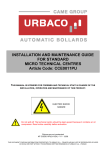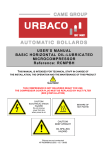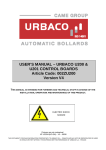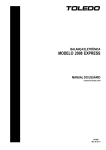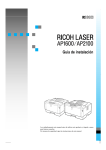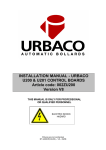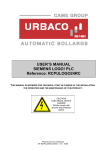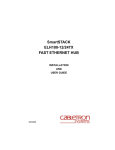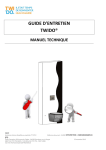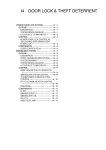Download installation and start-up of the city access controller 8633 – reader
Transcript
URBACO S.A. INSTALLATION AND START-UP OF THE CITY ACCESS CONTROLLER 8633 – READER 6000 BADGE READER 1 ACCESS –REF: C3S1L610P The City 3 controller described in this document is in conformance with the CE standard. It fulfills the requirements of the following standards and regulations (as a whole and at the level of each of its components): EN 50081-1 (1992 edition) EN 50082-1 (1997 edition) EN 50 022 UL 94 V-O DIN 43 880 CEM U98/001 (Directive 89/336/CEE) 1 URBACO S.A. SUMMARY I DESCRIPTION OF THE EQUIPMENT ................................................................ 3 II DESCRIPTION OF THE CITY 3 CONTROLLER................................................ 4 2.1- Components....................................................................................................... 4 2.2- Access to the components ................................................................................ 5 2.3- Designation of the components......................................................................... 6 III INSTALLATION OF THE CITY 3 ...................................................................... 8 3.1- Place .................................................................................................................. 8 3.2- Installation diagram ........................................................................................... 8 3.3- Installation cables .............................................................................................. 9 IV ELECTRICAL CONNECTIONS....................................................................... 10 4.1- Connection to the bollards and to the loops.................................................... 10 4.1.1- Passing through of the cables in the City 3 frame ....................................... 10 4.1.2- Connection(s) ..................................................................................... 10 4.2- Cabling general diagram ................................................................................. 12 V PNEUMATIC CONNECTIONS ........................................................................ 13 5.1- Connecting the City 3 flexible air line ............................................................. 13 5.2- Start-up of the City 3 controller........................................................................ 13 5.3- Connecting the flexible air line to the automatic retractable bollard ............... 13 VI TESTS AND ADJUSTMENTS......................................................................... 14 6.1- Tests and adjustments of the automatic retractable bollard ........................... 14 6.2- Information transmitted by the controller 8633B ............................................. 15 6.2.1- Information about the state of the functioning system........................ 16 6.2.2- Visualization of the accesses and the outputs ................................... 17 6.3- Operation of the badge reader 8634A............................................................. 18 6.3.1- General characteristics ....................................................................... 18 6.3.2- Configuration via PC and the CASCAM software .............................. 19 6.3.3- Operating principle and the display message ..................................... 19 VII- SPARE PARTS ............................................................................................. 20 2 URBACO S.A. 1 DESCRIPTION OF THE EQUIPMENT A controlled access is generally composed of three or four components linked together by electric cables and pneumatic or hydraulic flexible leads. - The security loops are electromagnetic detections, placed in the ground on both sides of the bollards. Presence or absence of a vehicle close to the bollards is detected by two or three loops according to the functioning logic of the system. These are the main parts of the security system. - The automatic retractable bollards put on the traffic way, allow or prevent access. One or two standard bollards per access are standard. Consult our technical service for more configurations. - The managing system: - Access controller with integrated technical center: City 3 or City 5 or radio model of the micro technical center) - City access controller type placed in a cabinet separated from the technical center. The managing system receives instructions from the user by a radio beep, badge reader, push button, etc, and manages the functioning of the access through a configuration and delivers the necessary control to the movement of the pneumatic or hydraulic bollards. It is powered with 220 VAC (16 A with ground). For the installation of the security loops and the automatic retractable bollards, refer to the appropriate installation guides. The positioning of the security loops governs the proper functioning of the access. First determine the placement of the loops, then those of the bollards and the managing system. 3 URBACO S.A. 2 DESCRIPTION OF THE CITY 3 2.1 Components The City 3 frame is a 324-mm diameter steel tube E24 (1) and is 6 mm thick. It is capped by a rounded top (2) and a disc (3) is soldered at the bottom. The bottom disc is fixed by three bolts between the sealed socket and the fixing disc. A thermal insulation and an internal insulation are integrated. The temperature must not exceed 45 °C in the City 3. The City 3 frame is 1645 mm high and weighs around 90 kg with its installed components. At the top of the structure is a polycarbonate front face with a thickness of 10 mm and a 3 color display. It allows communication with the user via red and orange 65-diameter-LEDs, electrochromeric display and contactless badge reader (9). At the center an emergency stop hatch (10) opens with a “fire fighter” key (11) (square or triangle imprints according to the option). The security service can initiate the opening of the access by pushing on the emergency stop button. At the bottom, the door (12) opens with a key (13) with special notch imprints. Access is granted to the internal components presented in the paragraph 2.3. External materials: - A fixing sub-plate (4) with three spray plates, three M12 screws and three nuts. - A fixation disc (5). Equipped as it is presented on page 7, the City 3 controls one or two bollards for one access. The type of access is configured as controlled access or output access or both controlled access and output access. The City 3 can operate in autonomous mode or the optional centralized mode. The centralized mode allows managing the remote access through optical fiber cables (or telephone lines with CASCAM light software), via control software and a central computer situated in a control room. The badge reader 8634 A of the City 5 is centralized (refer to paragraph 6.3.2 and consult the manual for the optional CASCAM software for more details). 4 URBACO S.A. 2.2 Access to the components 2.2.1 Opening of the door We need the special cylindrical key with notches (delivered). To open, push the key all the way in the lock, then turn it a quarter turn clockwise. The latch is maintained. The door falls over the back. Raise to release both feet from the bottom. Closure is operated in the reverse order. Verify correct positioning of the door in its seat before turning the key. 2.2.2 Opening of the emergency stop hatch According to the chosen option, the imprints of the key are square, triangular, or special (the special key is used by the security services: fire fighters, SAMU, etc). Firmly give the key a quarter turn clockwise, and then raise the hatch to free both feet at the bottom. A chain keeps the hatch open. 2.2.3 Opening of the front door Open the hatch using the step outlined in 2.2.2. In the bottom of the hatch, use a 6 pan male 5-mm key to unscrew (1) and to free the fixation feet (2). Once the base is free, the front slides down. Do not pull on the basic linkage (3). During the closure, verify positioning of the upper part, then place the whole and grasp the screw to the key lightly. 5 URBACO S.A. 2.3 Designation of the components 2.3 (1) Ventilator (at the bottom behind the gate) (2) Transformer (power of the controller 8633) (3) Chute (4) Transformer (power of the badge reader 8634) (5) Basic linkage of the front face (6) Fixation foot of the front face (7) Front face (8) Badge reader card 8634A. (9) Traffic light of the bollard movement (10) Positioning small ruler of the upper front face. View of the emergency stop hatch (11) Emergency stop button (12) Emergency stop hatch open 6 URBACO S.A. (14) City 3 structure: steel tube E24, diameter 324 mm, thickness: 6 mm. (15) PLC URBACO 8633 B (16) Automaton connection rack (17) Chute (18) Differential cut-out (19) Contractor command compressor (20) 220 VAC connection rack and fuses (21) Heater (optional) (22) On/off switch of the compressor (23) Manometer (24) Blow off Solenoid valve (25) Pressure switch (26) Connection of the flexible air line (behind the optional foot warmer) (27) Heater (optional) (28) Compressor 220 VAC (29) Connection rack of the Compressor (30) 4 silent block (31) Thermal and phoning isolation: sticky moss with an aluminum 5-mm film (32) Rounded base brazed (between the fixing disc and the fixing socket) (33) Platinum support of the compressor (34) Positioning angle of the electric cables from the conduit. 7 URBACO S.A. 3 CITY 3 INSTALLATION 3.1 Location The City 3 controller must be placed within 3 or 4 meters from the bollard: The driver of the stopped vehicle must see the bollard (or bollards) when using a badge. The vehicle must be on the security loops during this operation. 3.2 Installation diagram 8 URBACO S.A. 3.3 The connecting cables From the City 3 to the electrical panel: .......... From the City 3 to each bollard: ..................... switch) 1 cable 3G 1.5 mm² in H07RNF 1 cable 5* 1.5 mm² (solenoid, upper and lower limit 1 cable 2* 1.5 mm² per option (heater, illuminated crown) 1 10 mm diameter flexible air hose from the city 3 to each loop:…………………… 1 twist pair multiwire cable 2* 1.5 mm², of a diameter of 7 mm (loops tail). Consult the installation notice of the loops for their operation. Option: to the centralized system: 1 telephone cable or optic fiber 9 URBACO S.A. 4 ELECTRICAL CONNECTIONS 4.1 Connection to the bollard and to the loops 4.1.1 Passing-through of the cables in the City 3 structure An angle post is soldered in the City 3 (vertically on the left, n° 34, page 7). It allows to attach the electric cables from the conduits with the clips (sold separately) from the base to the connection rack (N° 18 to 21 page 7). The security loops (twisted pairs) must not be located near the other conductors but vertically on the right side of the City 3. We use adhesive sub-plates (sold separately) for collar support. 4.1.2 Connections ALL THE CONNECTIONS MUST BE MADE WITH UNIT DEENERGIZED (A) 2 solenoid conductors (10 and 11 on the connection rack of the PLC) (B) Lower limit switch (26 and 28), and optional upper limit switch (22) (C) Both of the conductors of each loop are twisted to the connection rack (D) Take out the cut-out from its rail in order to connect the 3 conductors (220 VAC + ground) 10 URBACO S.A. Note: crimp a terminal at the ends of each used conductor when it is part of a multiconductor cable. Tape the ends of each cable. 1) Connect the cable 5 * 1.5 mm² from the bollard FROM THE BOLLARD Terminal strip of PLC on the City 3 The 5 conductors have been picked out during the installation of the automatic retractable bollard. One of them (FdcH) is only used with the "upper limit switch" option. Cables have no polarity. Both conductors can be reversed. DO NOT CONNECT ANYTHING in 37, 38, 35, 36 (no cable, no radio antenna) Both of the conductors of the solenoids correspond to 10 and 11. Both of the conductors of the "lower limit switch" correspond to 26 and 28. In case of the option of "upper limit switch": The common of both of the "upper and lower limit switch" correspond to 26, The other conductor of the "lower limit switch" corresponds to 28, The other conductor of the "upper limit switch" corresponds to 22, Tighten the screws of the connection rack. 2) Connect the loop's twist (N°1) Make sure to intertwine both of the conductors to the connection rack (at least 1 twist for each 10 cm). Insert the ends of both of the conductors corresponding to 69 and 70 and tighten the screws of the connection rack. 3) Connect the loop's tail (N°2) 4) While reenergized connect the electric power to the circuit breaker of the connection rack Remove the circuit breaker from the rail by reaching down to the connection rack. Insert the ends of the 3 conductors (ground, phase and neutral) and tighten the screws on the connection rack. Replace the circuit breaker on the rail and tighten the screws on the connection rack. 4.1 Cabling general diagram 11 URBACO S.A. 12 URBACO S.A. 5 PNEUMATIC CONNECTIONS 5.1 Flexible air hose connection to the City 3 Cut 1 cm off the end of the flexible hose. The cutting must be sharp and perpendicular. Attach the end to the adapter, at the left under the valve (N° 26 page 7). The locking generates a "click". DO NOT BEND THE FLEXIBLE AIR HOSE Note: Do not shorten the flexible hose because it is used as a reserve for the compressor. 5.2 Start-up of the City 3 controller The components of the City 3 controller have been pre-regulated in the factory. The start-up is operated with default options (refer to the 8633B controller guide). 1) Switch off the compressor (off, to the right). Refer to N° 22 page 7. 2) Apply the voltage to the differential circuit breaker (push it up. Refer to N° 18 page 7. 3) Wait 5 to 10 seconds for the initialization of the controller. Refer to N°18 page 7. The display indicates the following: 8633B VX.X where X.X indicates the software version (V2.2 in March 2002 for example) Then after 3 seconds: INITIALIZATION and ending a state message: BOLLARD IN THE DOWNWARD POSITION (or other position according to the initial configuration of the PLC and with no importance at this stage because the compressor is not functioning). 4) CHECK THAT THERE IS NO VEHICLE OR STEEL OBJECT ON THE LOOPS AND PUSH ON THE BUTTON "RESET DET." of the keyboard of the controller. There must be no presence detected on the loops. NOTE: The initialization procedure of the loops detector described above in (4) is necessary after each loop sensitivity configuration change and malfunctioning testing (refer to the 8633B controller guide). NO VEHICLE MUST BE PLACED on the loops when you push on the "RESET DET." button. 5.3 Connection of the flexible air hose to the automatic retractable bollard There are times when the automatic retractable bollard has been installed prior to the installation of the City 3, or it is used during the installation of the City 3 (refer to the installation and the connection guide for automatic retractable bollards, page 12). In these situations, the bollard's cover must be removed. 1) Unblock the flexible air hose on the side of the bollard. Switch on the compressor (on, right) in order to clean the flexible hose (10 seconds). Stop the compressor. 2) (Refer to the picture on the following page for N°5 and N°1) Cut the flexible hose (5) 1-cm from the end. Cutting must be sharp and perpendicular. Connect the flexible hose to the valve with a short cable (tools and crimping sold separately). Push the flexible hose (5) without bending it in conduit. 13 URBACO S.A. 3) Visual controls: check that no cable will interfere with the movement of the bollard. (1) Short connection (2) Regulator (3) Solenoid (4) Lower/upper limit switch (optional) (5) Flexible hose to the compressor 6 TESTS AND ADJUSTMENTS 6.1 Test and adjustment of the automatic retractable bollard 1) Check that the emergency stop button is not switched on. 2) Switch on the compressor. The bollard must rise. On the City 3 front side, the red light signal blinks during movement of the bollard, then remains on (steady light signal) when the bollard reaches its up position. The LCD display indicates the date and the hour on the first line and the message “your badge please” on the second line. 3) Place a vehicle on a safety loop and bring a valid badge in the reading zone, on the front face of the City 3. The LCD display must indicate: “opening of the bollard” and “take off the badge” (consult the 6.3.3 paragraph if another message displays). The bollard must descend. As soon as the bollard has reached its down position, the red light signal switches off and the orange light signal blinks (or the green light signal switch on according to the chosen signal). Note: the badge reader 8634A does not supervise the movement of the bollard (it is the role of the 8633B controller). After the indication of the message “opening of the bollard, take off your badge”, the LCD display of the front side displays the hour, and the message “your badge please”). 4) Remove the vehicle from the safety loops. The orange (or green) light signal must blink and the bollard must rise. As soon the upper position is reached, the red light signal remains switched on (steady light signal). 14 URBACO S.A. 5) Adjust the rising speed of the bollard using the control knob (2) (debit regulator) placed at the solenoid’s output. Use the on/off switch of the compressor for testing. The rising time of the bollard should be around three to five seconds (too much rising is not recommended). If there are several bollards on the access, adjust each to the same rising time. After the tests and adjustments, operate the finishing of the ground if it is not yet (confer to the installation notice and the connecting of the retractable automatic bollards, page 12) and close the cover of the bollard according to the traffic way. 6.2 Transmitted information by the 8633B controller This paragraph summarizes very briefly certain functions of the 8633B controller. The configuration mode, which is reached through the “RUN STOP” key, is not discussed here. So avoid to pushing this key. If the key “RUN STOP” has been pushed by mistake, the screen displays SETTING MODE. Then ACCESS1 SETTING. Simultaneously, the bollard is in the down position. Leave this configuration mode by pushing one more time on the “RUN STOP” key. The screen displays briefly END SETTING. The system reinitializes itself (display of the message 8633B vx.x then INITIALISATION). Caution: if the loops do not detect a presence, the bollard rises. In order to obtain more detailed information; consult the 8633B controller manual. LCD screen Engaging tab on the DIN rail Switch on light Key board Opening of the transparent cover 15 URBACO S.A. 6.2.1 Information about the functioning system During the normal functioning of the system, the controller displays informative messages on its screen. In the held over position, the bollard is in the up position and the screen displays in alternately the following message: “BOLLARD UP”, as well as the message SETTING = STOP. These messages inform the user to move on to the configuration mode (refer to the 8633B controller user’s guide). With a descent command, an access cycle starts (the bollard descends and then rises). At the end of the cycle, the bollard’s position then corresponds to the display in real time. Exception: the operator commands the descent of the bollard, but does not go over the access. After 3 minutes the display indicates “WAIT PASSAGE”. The bollard will rise only after the crossing of a vehicle on the safety loop or loops by pushing the RESET DET. key. Caution: if the detection is sensitive, the crossing of a bicycle can activate the rising of the bollard. The detection of an anomaly can activate the system’s security by lowering the bollard and display an alarm corresponding to the anomaly. WAITING L L.SW. if a lower limit switch is not detected, WAITING U L.SW. if an upper limit switch is not detected (only if this option has been chosen), DEFAULT COMPR. For an excessive run time of the compressor. In this case, a technician must intervene. A default on a loop does not activate the security but activates the display: SAF1 = D or SAF2 = D for an open safety loop or a short-circuit. This message is only visible through the access and output menu mode (refer § 6.2.2). If a descent command is activated, the bollard will remain in the down position because one of the loops is considered as activated. The loop’s default is interpreted as the presence of a vehicle. The security of the bollards is assured by the state of the electromagnetic loops before and during the rising movement, in order to reduce the shock of a vehicle. When metallic presence is detected on one of the bollards: - it remains in the downward position if that is the existing position - if the bollard is rising, it descends if metal is detected Caution: The inertia of the system does not allow reversal of movement in a short time period to avoid bollard contact with a vehicle if the vehicle does not stop. Note: A vehicle must not remain on the safety loop when the bollard is in the down position. After 15 to 20 minutes of parking on a loop, the vehicle’s presence may no longer be detected. In this case, the bollard will try to rise. If prevented from rising, it descends again, and after three attempts the system defaults. 16 URBACO S.A. 6.2.2 Accesses and Outputs Menu To enter the accesses and outputs menu of the controller which links with its peripheral, push the “DATA” key. Move by scrolling. Screen display Information 1 :LLSW=x ULSW=x Upper and lower limit switch. x for 0 or 1 1 :SAF1=x SAF2=x Safety loops 1 and 2. x for 0 or 1 or D 1 :EM.ST=x COMP=x Emergency stop, compressor. x for 0 or 1 1 :A CD=x D Cd=x Rising, descending ordering. x for 0 or 1 1 :RLIG=x O.LIG=x Red or orange light signal activated. x for 0 or 1 1 :SV=x DEF.COM=x 1 : nnnnnn CYCLES Solenoid activated, compressor at default. Number of cycles (de 000000 to999999) x=0 means not activated, x=1 means activated and x=D for default (on the loops). The values symbolized by “*” or “nnnnnn” are updated and monitored several times per second. It displays in real time. The accesses and outputs menu mode is left after 10 seconds without action. It is possible to freeze the display by pressing the ENTER key for 2 seconds. In this case the “+” key and the “-” key remain active. In this visualization mode, the RESET DET. key (reinitializes the detector loops) remains active. The ENTER key remains inactive. Note: The accesses and outputs menu mode is operated in the same manner when the system is functioning and when it is in alarm mode. 17 URBACO S.A. 6.3 Functioning of the 8634A badge reader The 8634A badge reader card has the following functions: - the recognition of the badge presented by the user, - the authorization or the refusal of the opening of the access, - the display of the message adapted to the situation, - the archiving of the all actions This paragraph summarizes certain functions. It does address CASCAM or CASCAM light software, which are not delivered with the City 3 controller and are detailed in specific manuals. 6.3.1 General characteristics The 8634A is a contactless badge reader made for access control. It is centralized via RS232 or RS485 and allows the simultaneous commands of four accesses. It has an integrated control for LCD display or optional ticket printer. The powerful CASCAM software is made for access management. The basic function allows to generate up to 6000 badges gathered in 15 different groups, which has different accesses possibilities (1000 badges gathered in 7 different groups with the CASCAM software light). For each group, you can program 2 time slots for daily authorization. Every day of the week is independently programmable (for example Monday 8h-12h and 14h-18h, Tuesday 10h-11h and 15h-19h, etc.). An expiration date of the group is determined. During the authorized times slots, we choose if the accesses and the outputs are free or if they are subject to the refusal of a badge that has already been presented to the same access controller during a configured delay to eliminate several vehicles using one particular badge. The “permanent” badges correspond to a group with benefits of all the rights: permanent authorized passing, and no anti-passback. They are used by security services (light-fire, ambulance, etc). The option “delivery button” allows the deliverer to obtain the opening of the access by pushing on a contact button instead of using a badge during configured days and hours. Automatic filing stores up to 2500 events (N° of the presented card, time, acceptance or refusal). This information is obtained by connection of a PC or through centralization. 18 URBACO S.A. Through the autonomous functioning (not centralized), several 8634A readers can receive the same identification number and can allow the same access rights to the badge owner. 6.3.2 Configuration via a PC computer running the CASCAM software (or CASCAM light) Every badge (not programmable) has a unique identifier coded with 8 figures in hexadecimal that is to say more than 4 billion possible combinations. The CASCAM software (or CASCAM light) functions on a portable PC, or on a fixed computer if centralized. The software associates the owner of each badge to a group. The software also allows defining the groups and their rights (hours, time of authorization of each day of the week, and expiration date). Consult the installation manual for the CASCAM software for more information. The connection of the portable computer with the 8634A card reader is made by connecting RS232 or RS485 terminate by a shaver socket DB9 which is located at the right of the bollard, above the switched on manometer. Rapid connection with the portable computer is possible. Both the City 3 and the portable computer must be powered. Following the instructions of the CASCAM software makes the transfer of the information from the computer to the card reader 8634A. Consult the user’s manual. Note: if the access has already been operating, information can also pertain to past action from the card reader 8634A to the PC. After downloading, a badge can be read by the 8634A card reader: - read the identifier - search this identifier in the authorized list - determine the group with which it is associated (if it figures in the list) - read the rights of this group - decide if these rights authorize the opening of the access - to decide to send a command to open the access 8633B controller - display an appropriate message on the LCD screen, - to file the information corresponding to the events 6.3.3 Functioning principles and display message The communication is made through a liquid crystal display of two 16-character lines or 4 optional lines of 20 characters each. The user presents a badge in front of the indicated zone on the front side within 2 to 3 centimeters. The badge is recognized and the display status changes. 19 URBACO S.A. 7 SPARE PARTS Designation LCD display - 2 lines of 16 characters - 4 lines of 20 characters Reference Illustration page number RAFF216 RAFF420 4 8 8633B PLC (CPU 8633 one access, 2 integrated detectors) RCPU8633 7 15 Emergency stop button RBAU 6 11 Traffic light of the bollard movement - red / orange - red / green RCFERO RCFERV 6 9 Heater RCHF50 7 27 Thermal isolation for heater RTHM 7 21 Key of the city 3 door RCLEC3 4 13 City 3 frame RCITY3N 4 1 Fixing disc RCITY3E 4 4 Polycarbonate front face RFAPFL3 4 6 Centralizable badge reader (card 8634A) RLEC8634 6 8 Vertical micro compressor RCMPV 7 28 Blow off solenoid valve REVV 7 24 Manometer for micro compressor RMCMP 7 23 Pressure switch RPRST 7 25 Emergency stop hatch RTAUC3 6 12 Ø 75 cm Antenna for badge reader Contactless badge reader made for access control, engraved (gathered by 10 minimum) Screen print on one side, black (20 to 200 badges) Screen print on one side, color (20 to 200 badges) Air filter for micro compressor Antenna module of the badge reader 8634 V1 model, contactless RANTL75 RBDGLG RBDGLG1S RBDGLG2S RFLTA RMODLV1 20 URBACO S.A. TRAINING SESSIONS Urbaco is pleased to offer technical training sessions. These first level sessions last two days and the second level sessions last three days. These sessions can be conducted in French, English and Spanish. MAINTENANCE CONTRACT Urbaco offers a maintenance contract that will meet your needs: Maintenance contract: Preventive maintenance. Preferred Care Contract: Worldwide maintenance; includes travel expenses, labor, simplified maintenance budget, and urgent intervention plan. AFTERSALES SERVICE URBACO S.A. - Z.A. du Couquiou 84320 ENTRAIGUES - FRANCE Tél : 04 90 48 08 08 - Fax : 04 90 48 00 88 Tél export : (33) 4 90 48 08 00 E.mail : [email protected] 21





















